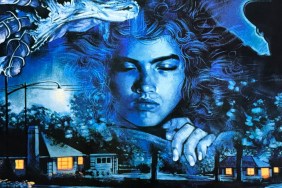
High school is a traumatic experience for most adolescents. Not only are you faced with a changing body, but the looming responsibilities of adulthood are around the corner, while insecurities run amok in the student population. Few people laugh at films like Mean Girls and Heathers because theyre funny; they laugh at them because they see the kernels of truth, high school is a battlefield and the fight is for independence. The same goes for horror films which utilize the high school setting. Many horror films employ the tropes of a vacation or a job which takes the characters away from their home so as to alter their surroundings and put them in danger. Films set in a high school become terrifying because the heroes are at home, but everything they thought they knew and understood begins to rapidly change as they are forced to take control of their own lives or risk losing them.
Brian De Palmas seminal horror film Carrie (1976) utilizes the inherent melodrama of high school and intensifies it by giving the schools titular outcast Carrie White (Sissy Spacek) telekinetic powers, which she uses at the climax of the film when her classmates humiliate her with a cruel prank. In De Palmas film, the two adults who are present throughout are Carries mother Margaret (Piper Laurie) and the gym teacher Miss Collins (Betty Buckley). These two characters are actively trying to move Carrie in opposing directions, her mother wanting her to stay at home and repent for the sins she believes Carrie has brought upon herself, and Miss Collins actively trying to help Carrie ingratiate into the school community. However, as prom shows, high school is not ready or willing to welcome Carrie White into their playground nor is her mother willing to welcome her back home. For Carrie, she has two options – to conform to her mothers will or the peer pressure at school. Ultimately, she is unable to do either, presenting a nihilistic look at the world through the microcosm of high school; different will never be welcome.
Kimberly Peirces 2013 remake uses large sections of Lawrence D. Cohens 1976 script with some updating by Roberto Aguirre-Sacasa. While the 2013 hews closely to the 1976 original, they add in storylines from Stephen Kings novel to flesh out aspects and characters, particularly the bully Chris Hargensen and Carries would-be ally Sue Snell. The opening scene of the remake remains mostly the same, with Carrie (Chloë Grace Moretz) getting her period for the first time and the rest of the girls taunting her with plug it up! The remake sees Chris filming the incident with her phone and later uploading it to the internet, which involves the school (rather than just Miss Collins/Desjardins) with Chris punishment. While we dont see the widespread effect of the video, the threat of the video is permanent as it could damage Carries reputation well beyond high school.

The film adds in much of Stephen Kings original ending, which De Palma couldnt afford to do in 1976. This sees Carries telekinesis causing destruction of the town and burying her home with falling rocks. While Carrie 2013s larger studio budget certainly aided in the ability to add in these effects, its also interesting to note that Carries powers grow and expand to seemingly effect a large part of the town just as the initial mocking in the change room spread further due to Chris video; implying that the further trauma reaches, the further the revenge can too.
In 1984 audiences became terrified of their bedroom, not for what might be under the bed, but for who was waiting for them in their dreams. Wes Cravens A Nightmare on Elm Street introduced the world to Freddy Krueger (Robert Englund), an undead killer who pursued the children of Elm Street in their dreams to seek revenge for what their parents did to him. The kids were archetypal high school kids; the good girl, the bad boy and Johnny Depp in a football crop top. A Nightmare on Elm Street is worth examining in the context of high school horror because it deals with a personal and private trauma affecting the everyday existence and reality of these teens. As the threat of Krueger becomes increasingly real, we see how it seeps into their lives that mainly consist of attending high school. The films Final Girl, Nancy Thompson, has a nightmare in class while sleep deprived. She sees the body of her friend Tina dragged in the hallways, leading her to the boiler room where she first meets Freddy. This is where Nancys mind merges the dream world and the real, creating an unsafe and unstable environment where the boogie man can emerge from anywhere and make the familiar foreign.

Like the remake of Carrie, Samuel Bayers A Nightmare on Elm Street was derided by many fans who felt the grim re-telling of the story was a transparent cash grab. The remake is sleeker and more stylish than the original, which can be chalked up to the larger budget and Bayers music video background. Like Carrie, it does include some more elements from the original story. Craven had intended for Freddy to be a child molester, however, he was made into a child murderer as the studio was concerned about a real-life high profile case impacting the reception of the film. In the remake, Freddy (Jackie Earle Haley) is a child molester and targeted the teens in this film when they were in preschool. The new millennium children of Elm Street are watched over more fervently by their parents out of guilt by what transpired when the children were younger and hoping that theyll never remember the initial trauma. As the teens uncover the mystery, they realize that they have no idea who they truly are. This can only be remedied by returning to the site of the original trauma, forcing them to relive and reclaim their lives. Their lives up until this point have been sanitized and unremarkable. It is only when an undead killer begins to haunt their dreams that their bland and boring high school becomes a place of danger. They can only return to it once they uncover the truth for themselves.

In both the Carrie and A Nightmare on Elm Street remakes, the characters navigate their way through high school without ever having full control of their lives. It is only when a supernatural element shows itself that everything begins to change. None of the films offer a solution or happy ending because for these teens, they have to be careful what they wish for if they want to make it to graduation.
—
Alexandra West is a freelance horror journalist who lives, works, and survives in Toronto. Her work has appeared in the Toronto Star, Rue Morgue, Post City Magazine and Offscreen Film Journal. In December 2012, West co-founded the Faculty of Horror podcast with fellow writer Andrea Subissati, which explores the analytical side of horror films and the darkest recesses of academia.









